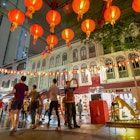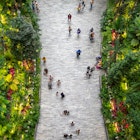
Apr 16, 2024 • 12 min read
Singapore's allure goes beyond its iconic hotels, manicured gardens and world-class airport – here are the best places to visit when you arrive.

Apr 16, 2024 • 12 min read
Singapore's allure goes beyond its iconic hotels, manicured gardens and world-class airport – here are the best places to visit when you arrive.

Apr 6, 2024 • 6 min read
Singapore enjoys tropical summer vibes all year round, making it a joy to visit whatever you're planning to do. But still, pack an umbrella just in case.

Mar 9, 2024 • 6 min read
Here's what you need to know about health, safety and etiquette before traveling to Singapore.

Mar 8, 2024 • 6 min read
Experience the best of Singapore as a family with this guide to traveling the Lion City with kids.

Mar 8, 2024 • 5 min read
While prices in Singapore are akin to most other major international cities, there are plenty of ways to explore Singapore without breaking the bank.

Mar 8, 2024 • 6 min read
Get around like a local in Singapore with this guide to its extensive public transport system.

Mar 7, 2024 • 7 min read
Don't be fooled by its size – Singapore has an overwhelming amount of attractions. Start your must-see list now with our top 10 best things to do.

Sep 7, 2023 • 3 min read
Find out whether you need a visa to visit Singapore, what types of visas are available the visa rules for trouble-free travel.

Aug 31, 2023 • 7 min read
A trip to Singapore needn’t break the bank. Here’s our pick of the best things to do in the city-state that are completely free of charge.

Oct 2, 2022 • 10 min read
Singapore may take less than an hour to drive across, but it has a wealth of tasty dishes that reflect the diverse cultures that call this island home.

May 12, 2022 • 5 min read
No need to head straight to Thailand or Indonesia: tiny Singapore has a wealth of fabulous beaches.

Oct 27, 2021 • 6 min read
While hiking in Singapore may not be top of mind, it’s fast becoming one of the city-state’s favorite pastimes.

Oct 13, 2021 • 5 min read
Singapore is streets ahead of most other destinations when it comes to green urban spaces. Here's our guide to the best parks and gardens in Lion City.

Dec 19, 2019 • 5 min read
With grand stations, lush tropical countryside and some great stop-offs, Singapore to Bangkok is a wonderful train ride. Here’s how to do it yourself.

Jul 17, 2019 • 5 min read
With their plethora of choices and chaotic pace, Singapore’s hawker centres can seem daunting at first. But with a bit of savvy, you can navigate the city…

Jun 5, 2019 • 5 min read
Free, and open to everyone, parkrun has gripped millions across the globe since its inception in 2004. So much so that every Saturday morning there are…

Apr 12, 2019 • 5 min read
A unique blend of Chinese ingredients and Malay cooking styles, often with Indonesian and Indian elements, Peranakan food is Singapore’s oldest – and…

Feb 18, 2019 • 5 min read
They say New York is the city that never sleeps, but in Singapore you can now eat, drink, and even fish around the clock. Begin your night at any one of…

Feb 6, 2019 • 2 min read
Lights, camera, more lights…and ACTION! Chingay, Singapore’s multinational extravaganza, is Asia’s largest street performance and float parade. Held…

Nov 27, 2018 • 6 min read
Germ-laden airports, upended sleep patterns and unfamiliar local bugs are just a few of the health risks travellers face when seeing the world. But…

Sep 19, 2018 • 6 min read
Singapore may look small, and geographically speaking it is, but this tiny island city-state is jam packed with a myriad of things to do, see, buy and…

Oct 27, 2017 • 5 min read
Singapore’s prolific super-slick and shiny shopping malls are often touted as some of the world’s best, and make this tiny island a must-shop for retail…